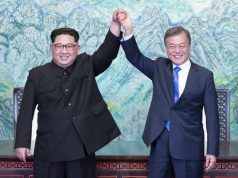VIENNA: A month after North Korea’s nuclear test, a monitoring agency said yesterday it was highly unlikely to find any “smoking gun” radioactive traces from the blast, potentially leaving important questions about the device unresolved.
The lack of this kind of telltale scientific evidence would likely make it hard to determine what fissile material was used in the isolated Asian state’s third nuclear test, which was detected by seismic monitors.
“Without detecting radioisotopes it will indeed be impossible to distinguish” between a device with highly enriched uranium as the fissile core and one with plutonium, said nuclear expert James Acton of the Carnegie Endowment think-tank.
The Comprehensive Nuclear-Test-Ban Treaty Organization (CTBTO), which has a global network of monitoring stations designed to pick up radioactive traces emitted from tests, said it had yet to find any such signs.
“It is very unlikely that we will register anything … at this late stage,” CTBTO spokeswoman Annika Thunborg said.
Thunborg did not give details, but the failure to detect radioactive particles could indicate that North Korea managed to prevent any such release from the Feb 12 underground explosion.
The test-ban treaty was negotiated in the 1990s but has not taken effect because some holders of nuclear technology have not yet ratified it, including the United States and China.
 But the organization already monitors possible breaches, deploying more than 270 stations worldwide to look out for signs of atomic tests, including seismic waves and radioactive traces.
But the organization already monitors possible breaches, deploying more than 270 stations worldwide to look out for signs of atomic tests, including seismic waves and radioactive traces.
It can take weeks to pick up radioactive so-called noble gases, depending on the weather.
“We are confident that the system works very well,” Thunborg said. A senior CTBTO official last month said the “smoking gun” of any nuclear test would be the detection of radionuclide traces.
Stronger explosion
North Korea’s third test yielded a stronger blast than its previous explosion four years ago, and Pyongyang said it had made progress in miniaturizing an atomic weapon.
While estimates of the explosive power of the latest test vary, most officials and experts estimate it was at least five kilotons, which is still smaller than the power of the atomic bomb the United States dropped on Hiroshima in World War Two.
US nuclear expert Siegfried Hecker said the February test would allow North Korea to eventually make smaller nuclear weapons to mount on missiles, but that it would not fundamentally change the security threat Pyongyang poses.
It “has very little plutonium and highly enriched uranium, limited nuclear test experience, and limited success in testing its long-range missiles,” he said in a New York Times article co-written with political science professor Scott Sagan.
In its 2006 and 2009 tests, North Korea is believed to have used plutonium. It abandoned plutonium production six years ago, following international pressure, but later acknowledged that it had built facilities to produce enriched uranium, which can also be used in bombs if refined to a high degree.
Without the trace evidence, however, US and allied officials have said it would be very difficult to determine whether the latest test involved a plutonium or uranium core.
Experts say plutonium, a by-product of nuclear reactors, can be difficult to use as bomb material because specifications have to be precise. It would be easy for North Korea to make large quantities of highly enriched uranium.
Despite the lack radioactive traces, Carnegie’s Acton and others said they were still confident that it had been a nuclear test, because of the magnitude of the blast.
“The North Korean device was definitely nuclear. The size of the explosion was far too large to be conventional,” Yale University geology professor Jeffrey Park said.









